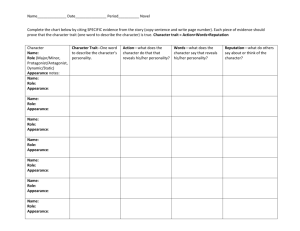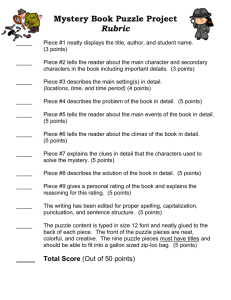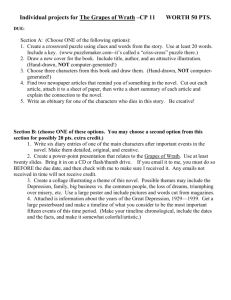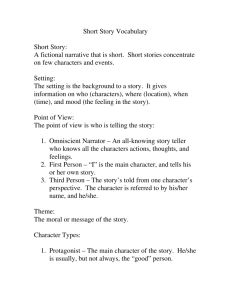Name: Period:___ Score: Due Date:______ Puzzle Piece Book
advertisement
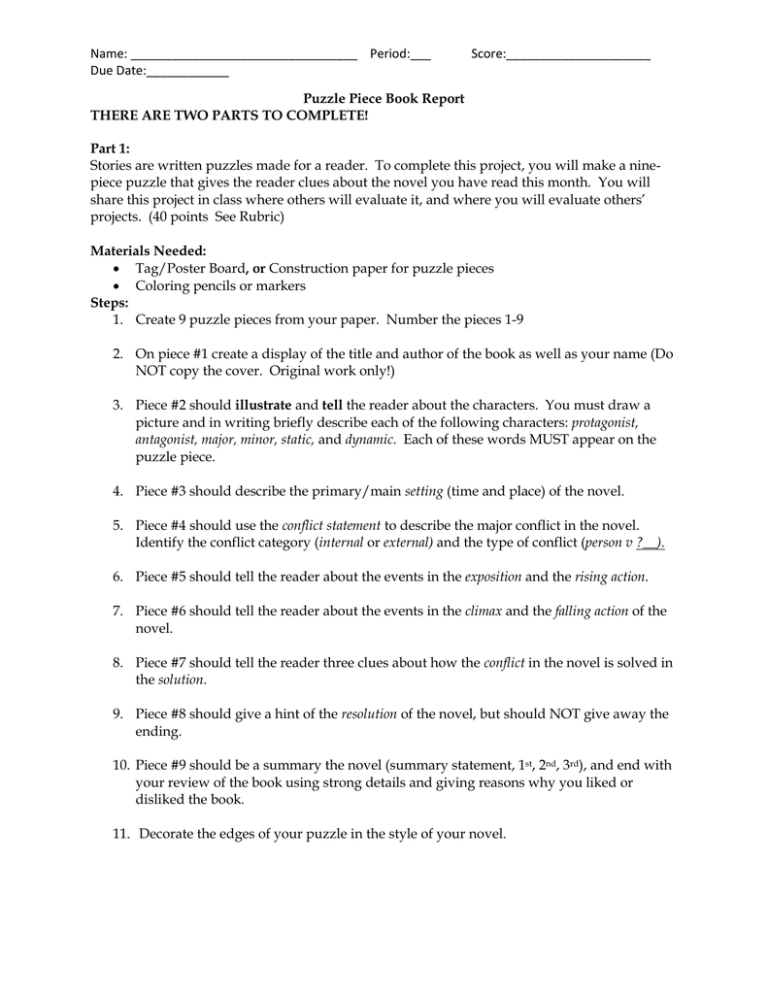
Name: _________________________________ Period:___ Due Date:____________ Score:_____________________ Puzzle Piece Book Report THERE ARE TWO PARTS TO COMPLETE! Part 1: Stories are written puzzles made for a reader. To complete this project, you will make a ninepiece puzzle that gives the reader clues about the novel you have read this month. You will share this project in class where others will evaluate it, and where you will evaluate others’ projects. (40 points See Rubric) Materials Needed: Tag/Poster Board, or Construction paper for puzzle pieces Coloring pencils or markers Steps: 1. Create 9 puzzle pieces from your paper. Number the pieces 1-9 2. On piece #1 create a display of the title and author of the book as well as your name (Do NOT copy the cover. Original work only!) 3. Piece #2 should illustrate and tell the reader about the characters. You must draw a picture and in writing briefly describe each of the following characters: protagonist, antagonist, major, minor, static, and dynamic. Each of these words MUST appear on the puzzle piece. 4. Piece #3 should describe the primary/main setting (time and place) of the novel. 5. Piece #4 should use the conflict statement to describe the major conflict in the novel. Identify the conflict category (internal or external) and the type of conflict (person v ?__). 6. Piece #5 should tell the reader about the events in the exposition and the rising action. 7. Piece #6 should tell the reader about the events in the climax and the falling action of the novel. 8. Piece #7 should tell the reader three clues about how the conflict in the novel is solved in the solution. 9. Piece #8 should give a hint of the resolution of the novel, but should NOT give away the ending. 10. Piece #9 should be a summary the novel (summary statement, 1st, 2nd, 3rd), and end with your review of the book using strong details and giving reasons why you liked or disliked the book. 11. Decorate the edges of your puzzle in the style of your novel. Name: _________________________________ Period:___ Due Date:____________ Part 2: Score:_____________________ Written Report (40 points—see summary, Ideas, and Organization rubrics): a. Write a summary of your story. Remember a summary is not a retell nor is it an explanation. A summary’s focus is on the important main ideas from the text so that someone who has not read the text would understand what it is about. **This summary is an essay. See the outline for the structure. Your summary must include: Title, author and all the literary elements book (characters-including protagonist, antagonist, dynamic, static-, primary/main setting, conflict/major problem, rising action, climax, falling action, solution, and resolution). b. Write a paragraph review of the book using strong details and reasons why you liked or disliked the book. c. Use the writing process—brainstorm, outline, draft, revise, edit. The first draft needs to be proof read by an adult; have your proof reader sign his/her name at the top part of your first draft. To turn in the report you must do both the written report and the puzzle piece project. If you do not finish reading the book, I will not accept your report. Outline Example for Summary and Review ***You may use this form to help you draft your paper. Some sentences are written for you—USE THEM. For others, you will need to supply information.********************************* Introduction Paragraph 3)Summary Statement (include title of book, author and what makes it interesting) 2) Complex Sentence that states the main idea of your essay (occasion/position, however, conjunctive) 1) Thesis: The exposition and plot of __________________(title) make this a__________(great / horrible) book to read. Body Paragraph 1 (include protagonist, antagonist, dynamic, and static characters; and the primary setting here.) 1)In the exposition of the novel, the main characters and time and place are revealed. 2) The protagonist and antagonist of the story are ___________ and ____________. 3) A detail about the protagonist: _____________ + page number/chapter 3) Detail about antagonist: ________+ page number/chapter 2) The dynamic and static characters are:______________________________________ 3)Detail that shows how/why a dynamic character changes OR what he/she learns + page number/chapter number____________________________ Name: _________________________________ Period:___ Due Date:____________ Score:_____________________ 3) Detail that shows that a static character doesn’t change + page/chapter # 2) The setting of the novel helps to make the story more real. 3) The novel takes place in (Time/s)____________________, which I know because (book evidence _______________________). 3) The majority of the action happens in (Place)______________________, which is clear because of (book evidence_______________________). 1) The details that the reader learns in the exposition help to set the stage for the conflict and action of the book. Body Paragraph 2 (include conflict, rising action, climax, falling action, solution, and resolution here.) 1) The plot of the novel starts from the events in the introduction and ends with the resolution. 2) The main conflict in the novel is (internal or external), and is person versus __________. 3) (Who)_________wants___________, but __________, so _______________. 3) This can be seen on page/chapter___ when _______happens. 2) The events in the rising action help to complicate the plot. 3) Major event 1:_________________________________________________ 3) Major event 2: ________________________________________________ 3) Major event 3: ________________________________________________ 2) The rising action leads to the climax of the novel, which is when ________________ happens. 3)This can be seen on page/in chapter____ when _________________ happens._ 2) In the falling action, the events move towards the resolution and the solution to the conflict. 3) Major event 1:_________________________________________________ 3) Major event 2: ________________________________________________ **Add more major events from falling action if needed 2) Finally, the solution to the conflict happens when _______________. 3) This happens on page/in chapter _________ when ________. 2) The story’s resolution is __________________________. 1(Title)’s plot is _______________ (suspenseful, entertaining, or….) Body Paragraph 3: General Review of the book 1) Reason you love/dislike this book_____________________________________ 2) One detail that proves/explains why I love/dislike it is ___________________________ 3) Book Example _____________________________________ Name: _________________________________ Period:___ Due Date:____________ Score:_____________________ 2) Another detail that proves/explains why you love/dislike it_____________________ 3) Book Example _____________________________________ 1) Readers who like ____________________ should read ________________. Conclusion Paragraph 1) The exposition and plot of __________________(title) make this a__________(great / horrible) book to read. (Re-word this sentence so it isn’t exactly the same as your thesis but has similar information.) 2) Complex Sentence (occasion/position, however, conjunctive)________________________ _________________________________________________________________________________________________ 3) Concluding statement (leaves the reader feeling satisfied/ tells the reader what to do with your ideas.) _______________________________________________________________________________________ Name: _________________________________ Period:___ Due Date:____________ Score:_____________________ Puzzle Piece Rubric __________Points earned 4--Mastery (4 points each) 1. Includes 9 pieces that are all high quality and show attention to detail and a relevant theme in the presentation 2. Organized, neat, easy to read, and in color 3. Includes a picture on 2 more puzzle pieces than is required (pieces 1, 2, _ & _) 4. Text based evidence from the story included frequently (quotes, examples, or page numbers, etc) 5. Elaborated, interesting and informative details included 6. Sequence of story clear and accurate ( pieces 5, 6) 7. Clues are clevwiler and relevant and do not give away the ending (pieces 7, 8) 8. On topic, strong word choice, not repetitive 9. No spelling, capitalization or punctuation errors 10. All literary elements easily identifiable and clearly labeled: Title, author and all the literary elements book (characters-including protagonist, antagonist, dynamic, static-, primary/main setting, conflict statment, exposition, rising action, climax, falling action, solution, and resolution). __________Points earned 3—At Standard (3 points each) 1. Includes 9 pieces that are all high quality and show attention to detail, and common theme 2. Organized, neat, easy to read, and in color 3. Includes 1 more picture than required (pieces 1, 2, & _) 4. Text based evidence from the story included regularly 5. Elaborated, informative details included 6. Sequence of story clear and accurate ( pieces 5, 6, 9) 7. Clues are relevant to story and do not give away the ending of the story (pieces 7, 8) 8. On topic, good word choice, not repetitive 9. Accurate spelling, capitalization or punctuation 10. Most literary elements identifiable, but they may not all be clearly labeled __________Points earned 2—Approaching Standard (2 points each) 1. Includes 9 pieces that are all good quality but lack attention to detail 2. Disorganized, messy, readable, and in color 3. Includes pictures where required (pieces 1 & 2) 4. Text based evidence from the story missing 5. Skeletal elaboration 6. Sequence of story clear ( pieces 5, 6, 9) 7. Clues may be confusing or simple statement of facts (pieces 7, 8) 8. On topic, poor word choice, repetitive in places 9. Spelling, capitalization or punctuation errors do not meet grade level standard 10. Few literary elements identifiable—reader must infer to understand __________Points earned 1—Below Standard (1 point each) 1. Includes less than 9 slides and/or slides are poorly done 2. Disorganized, messy, unreadable, not colored 3. Pictures are not included 4. Lacks evidence to show full understanding of the book 5. No elaboration 6. Sequence of story confusing ( pieces 5, 6, 9) 7. Clues give away the ending of the story (pieces 7, 8) 8. Off topic, overly simplistic word choice, repetitive 9. Significant spelling, capitalization or punctuation errors interfere with readability and presentation 10. Lacks adequate information to demonstrate understanding of literary elements
